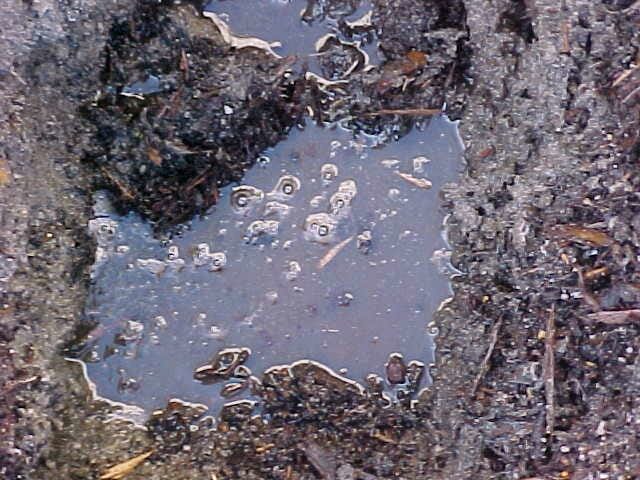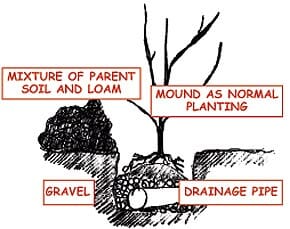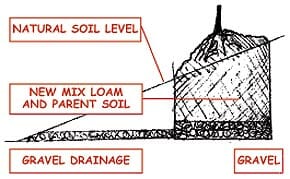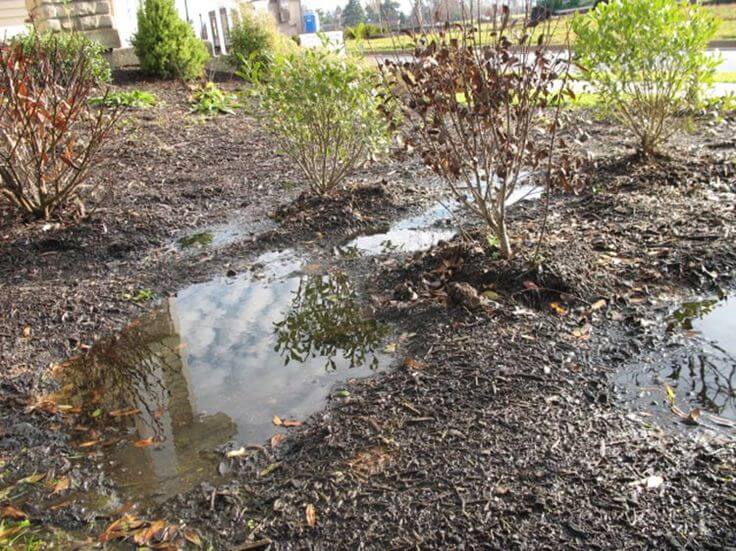Wet Feet is the number one plant killer, accounting for roughly 70% of all plant deaths in Melbourne that occur within the first few months after planting.
Chris has visited many customers’ properties in the past, both as a landscaper as well as assisting customers experiencing difficulties with establishing their plants. From decades of experience he has discovered that 7 out of every 10 cases of plant failure are caused by Wet Feet.
What is Wet Feet and what causes it?
When we say “Wet Feet”, we’re talking about a plant that is suffering due to a flooded or soggy root zone. A lack of oxygen in the soil around the plant’s roots occurs when the soil is saturated with water that is not draining away for more than a day. Plants need oxygen in the soil around their roots. This is how they breathe, and this water-logging actually causes them to drown!
In this wet environment, organic matter in the soil also starts to rot and uses up all of the available oxygen. This rotting can include the feeder roots of the plant! Feeder roots are the newly forming and delicate roots the plant sends out as it grows, to draw in oxygen and nutrients. Wet Feet causes plants to die both due to lack of oxygen being available for uptake through their roots, and/or rotting away their feeder roots so they can’t take up nutrients and water.
The most heart-breaking thing about Wet Feet is that it happens to the most well meaning plant parents. Many people, anxious to make sure their new plants survive and thrive in their garden, will tend to over-water their plants. Plants with Wet Feet can appear to be suffering from a lack of water (see symptoms below), so MORE water is applied in an effort to rescue the plant.
Watering itself is not really the issue: it’s poor drainage. Especially in warmer months, most plants benefit from big, frequent drinks. It’s when this water pools, doesn’t drain away and then starts going stagnant and rotting around their roots that the trouble begins. Here in Melbourne, many areas have a high percentage of clay in the soil. Clay is notorious for holding water and preventing drainage, so Wet Feet is something we have to be particularly careful of.
How to identify Wet Feet
Your plant and soil will show you signs of Wet Feet, so you just have to know what you’re looking for. Signs of Wet Feet include:
- saturated soil, non-draining soil
- a septic or anaerobic (aka stinky-poo) smell
- discoloured or dying plant roots
- wilting
- leaf scorch or browning of the leaf (That’s right, brown leaves can mean not enough water AND too much water)
- yellowing or browning on the edges of the leaves
Wet Feet is also often misdiagnosed as Water Stress (lack of water) as they both present some of the same symptoms. For more on water stressed plants, see our advice page here.
Check out the below video where Detective Jack Aranda (aka Chris) visits the scene of the crime in a “Wet Feet” plant death.
In what situations is Wet Feet commonly found?
Heavy clay
This is where plants are planted in heavy clay. The problem is a lack of air porosity, which refers to the amount of air pockets in the soil. These pockets are important for supplying oxygen and water to the plant, and providing tiny channels for water to travel through the soil and then drain away. Check out the science behind it here.
Particularly where there is a lack of good topsoil and the planting hole has been dug directly into very dense clay sub-soil, the dug hole creates a clay bucket. Clay is great for holding water (thing about how many ancient civilisations made water containers out of it) and very bad for letting it drain away.
No drainage
In courtyard areas, around driveways, concrete pathways or retaining walls many garden beds have no way for water to drain away from beneath the soil. Most shrubs and flowers require a well-drained root zone to a depth of 30cm, and small ornamental trees require a well-drained root zone to a depth of 40-60cm. Wet Feet is likely to occur where garden beds have been constructed and surrounded by hard landscaping (concrete, paths, retaining walls etc) with no provision for subterranean drainage of the root zone.
Planting in a bad soil mix
Some cheap garden soil mixes are made from a mixture of very fine sand and rapidly decomposing organic matter, like sawdust, pine bark, wood chips and chicken manure. These ingredients are OK if they have been broken down properly before the soil is sold and used for planting. Check out our video on toxic top soil and the other problems it can cause.
If the soil is not actually ready yet, within a few weeks the organic matter breaks down into a very fine material that clogs up the soil by filling up its air pathways. This causes the soil to compact into a very heavy, wet, badly draining, anaerobic (literally “without air”) soil. These soils can cause Wet Feet even when the garden beds are otherwise well drained.
For more on soils and mixes, see our Soil or Potting Mix advice page here.
Excessive watering of garden beds
Garden beds with automatic watering systems and garden beds that are down slope from an automatic watering system are often watered too frequently. This is particularly a problem at times when evaporation rates are low, like in the cool temperatures of winter. In Melbourne, far more plants die from over-watering than from under watering. Water pools, never has a chance to drain away, and bang: Wet Feet.
It is best to water by hand where possible, and use your automatic watering system when on holidays. This allows you to have a look at your plants and check the state of the soil. Do they really need it? An occasional long deep soak is generally better than watering all the time. Observe when your plants require water or when the soil is dry underneath and water at this time.
Laying instant turf
When instant turf is laid it requires constant watering for several weeks until it takes root. This can cause surrounding garden beds to become water logged. When putting in a new landscape with instant turf, establish the turf before creating and planting the garden beds. If you are putting in turf near already established garden beds, consider hand watering the turf to keep it wet without water logging the surrounding garden beds.
Digging a hole for a plant and throwing away the original soil
This is a combination of the problem of planting in hard soil or clay and using bad soil mix. Often when people dig a hole for a new plant and discover that the soil in the hole is very hard or heavy clay, they chuck out the original or “parent soil” that came out of the hole. Seeing that soil was no good, they fill the hole with some potting mix, compost or garden mix that is softer, lighter and more porous than the original parent soil. In goes their plant or tree. This is actually a recipe for disaster!
What happens is that the hole in the hard soil just acts like a big cup, filling with water and holding it in. This is because of the sharp difference in density between the original and the new soil. Water fills up the planting hole and can’t drain away, and the organic matter in the new soil decomposes and the plant will get Wet Feet.
When digging a hole in heavy or dense soil, or any garden bed you’re unsure about, follow our instructions for planting a tree (video below). Dig a big, deep hole, twice the width and height of the pot of the plant that’s going in. Fill in around the plant with a mix of 50% parent soil and 50% good quality soil, potting or planting mix. Use only slow release fertiliser such as Osmocote Slow Release fertiliser or Charlie Carp.
If you’re unsure what type of soil you have, find out here!
Common Wet Feet Myths
There are a number of popular myths about Wet Feet that defy the laws of physics.
Myth: I have sloping land so I can’t get Wet Feet
People on sloping land are actually more likely to get Wet Feet as water flows downhill and will get caught somewhere. Poorly drained garden beds and planting holes will flood more quickly and more often on sloping land. People with heavy or non-porous soil on sloping land who dig planting holes are more at risk of Wet Feet than people who dig their planting holes in flatter land.
Myth: I will put pebbles, gravel, bricks, clay breaker, compost in the bottom of the hole to make the water go away
Things like soil wetter in the bottom of a planting hole can be some defence again mild drainage problems. But if you dig a planting hole in totally impervious clay, the only thing that will make the water flow away is a drainage channel or a pipe. If you fill your bath with water, the way to empty it is by pulling the plug out.
Myth: If I dig a really big planting hole the water will definitely go away
Theoretically this may work, but you might have to dig to China! A big hole means there’s more area for water to spread out and drain out of, buying your plant more time with its “head above water” (think tipping a small cup of water in a leaky bucket). If the hole is deep, your plant has more chance of keeping its roots out of any water pooling in the bottom and might be able to “breathe” longer. Check out our instructions on doing a soil drainage test to get more of an idea on how this works.
However, when digging in impervious or poorly drained clay soils, a big hole may simply hold more water. This is especially bad if combined with over-watering. The only thing that will drain a really big hole is a drainage channel or an agricultural drainage pipe.
Myth: I just won’t water my plants
Not watering as an alternative to providing good drainage doesn’t work in Melbourne, as Melbourne has prolonged periods of rain that will saturate any poorly drained area. The sky is going to water (or over-water) your plants whether you like it or not! Not to mention, your plants need water to survive.
Identifying a potential Wet Feet problem area
If you have an area where you suspect you may have Wet Feet or want to check before planting, do the following:
- Dig a large hole to the depth that you intend to plant your plant to (that would be the same height as the height of the pot the plant will come in – pot size guide here). If you are planting an advanced plant you will need to dig a very deep hole.
- Fill the hole with water and let it drain completely.
- Now fill the hole with water a second time.
- The hole should drain within 20-30 minutes after the second filling with water.
- If the hole doesn’t drain or drains much slower than this, you have a potential Wet Feet problem.
Check out our article on understanding your soil type, which includes more information on soil drainage testing.
Prevention of Wet Feet
Don’t ever use toxic top soil that contain a mixture of fine sand, raw organic material that is still decomposing, and animal manures. Not only can they burn the roots of your new plants, but you can get Wet Feet even if your garden beds are well drained when using these products. See Chris’ video on how to fix your soil if you have received a potentially dodgy bulk soil delivery or are working with a raw block fresh from construction.
If you have identified a poorly drained area you can:
- Use Wet Feet hardy plants as listed under “Plants at low risk of Wet Feet”. Celtic Cascade® Salix caprea ‘Pendula’, is one of the best, as well as the Nishiki Willow.
- Ask our nursery staff for assistance to help you select Wet Feet tolerant plants.
- Provide drainage by mixing washed river sand, mineral gypsum at the rate of 3kg per M2, and fully composted pine bark throughout your soil to improve porosity. Don’t use more than 20% volume of these additive to 80% of the parent (original) soil.
- Use only slow release fertiliser such as Osmocote Slow Release fertilisers.
- Lay drainage pipes in the area, which are designed to draw water in and carry it away. More info below.
3 Good Ways of providing drainage
- Plant on a raised mound, as follows: Cultivate (dig up) a circle approx. 4ft wide x 1ft deep and add several wheel barrows full of loamy soil, such as good quality garden soil. Mix this up to 50/50 with your parent soil. Then create a mound to plant into. Many trees such as Weeping Cherries, Silver Birch, Elm, Pine and Oak will die if planted in water, but will quite happily grow their roots down into the water. Raising them up like this on a mound of soil is a good solution.
Create drainage channels, as follows: Dig a hole 40-60cm deep x 1.2m across then dig a trench and lay agricultural pipe to connect with the nearest storm water pipe. Put a gravel bed in the bottom of the hole so that the water drains to the storm water pipe. Then fill the hole with a mixture of 80% parent soil and 20% washed river sand, composted pine bark and 3kg/m2 of mineral gypsum.
One agricultural pipe, if laid strategically through the garden, can drain many trees and shrubs. Sometimes the stormwater pipes are buried near the soil surface and an agricultural pipe connected to the stormwater pipe will not provide drainage for the entire root zone of the plants being planted. This is becayse the actual stormwater pipe is higher than the garden bed and the water won’t flow uphill. If this is the case, the garden bed can be mounded or raised to provide suitable depth of soil for the agricultural pipes.
If you are planting into poorly drained soil on sloping land, you can drain tree root zones without connecting to a storm water pipe by digging a large hole with a narrow trench running downslope from the hole. Then fill the bottom of the hole and trench with gravel. Fill the balance of the hole and trench with a mixture of 80% parent soil and 20% washed river sand, composted pine bark and 3kg/m2 of mineral gypsum. Plant your new tree or shrub in the top of the hole. Water will now drain from the base of the hole through the gravel in the bottom of the trench.
Plants at risk of Wet Feet
Many plants are affected by Wet Feet but from analyzing our customers’ complaints and problems here are some of the most at risk plants. If you are planting these types of plants be diligent to avoid Wet Feet.
- Weeping Cherries
- Weeping & upright Silver Birch
- Pittosporums
- Mop Tops
- Gardenias
- Rhododendrons
- Proteas
- Azaleas
- Standard Ficus
- BoxOz® Lonicera
- English Box
- Weeping & upright Japanese Maples
- Citrus
- Fruit Trees
- Standard Roses
- Lavender
- Convolvulus Silver Bush
- Powton® Sapphire Dragons
- Myrtus Luma.
All very large advanced plants are more at risk of Wet Feet, as they have a large root mass and require a deeper hole. This means means that the bottom of the root mass is more likely to be planted in poorly drained sub soil like the heavy clay typical in many parts of Melbourne. This makes a larger more vulnerable to Wet Feet.
Plants at low risk of Wet Feet
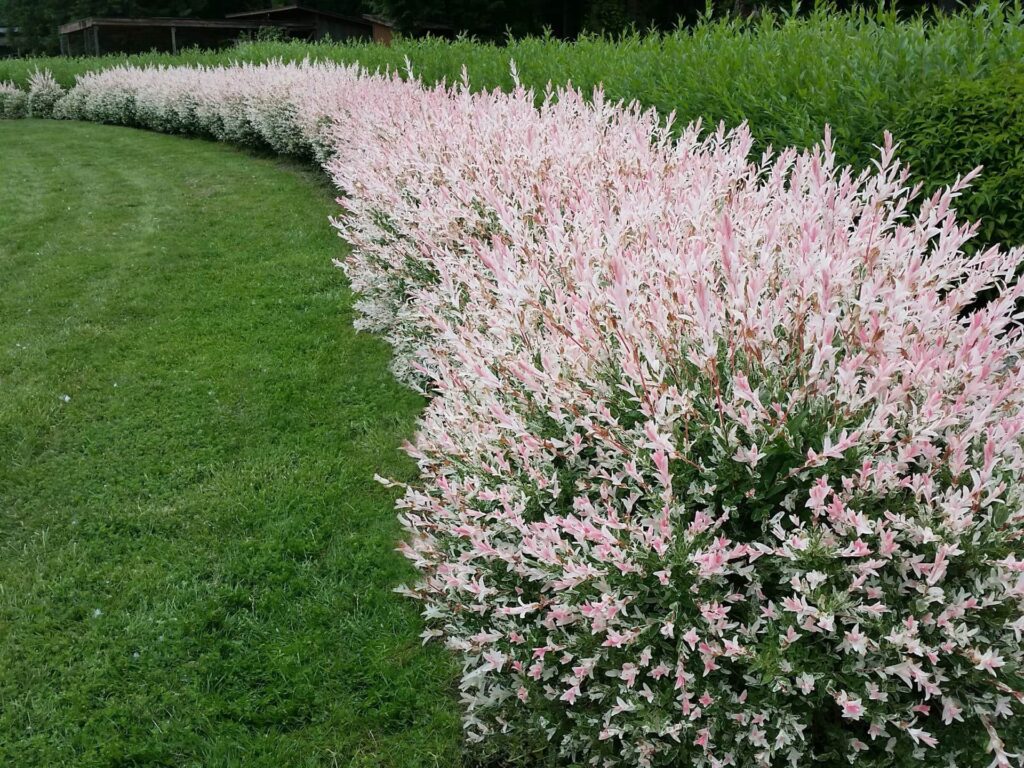
All plants can be adversely affected by heavy soil and Wet Feet but these plants seldom have Wet Feet problems or generate customer complaints.
- Celtic Cascade® Salix caprea ‘Pendula’
- Variegated Nishiki Willow
- Evergreen Cascade® Alder
- Toorak ‘Gum Tree’™ Alder
- Dwarf Nandina
- Mondo Grass
- Bongo Borders® Liriope
- Photinia Robusta
- Box Leaved Privet
- Carpet Roses
- Rock Roses
- Seaside Daisy
- Castlewellan Gold Cypress
- Neighbours-Be-Gone®
- Acmena smithii
- Chinese Elms
- Plane Trees
- Ash Trees
- Hydrangeas
- Viburnum
- Wiegelia
- Golden Diosma
- Callistemon
- Melaleucas
- Eucalyptus




